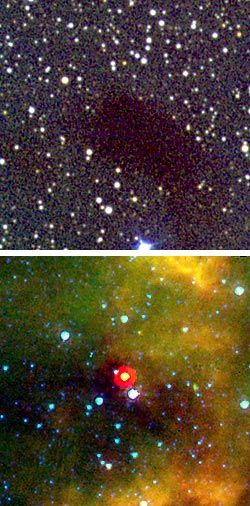
Seen in visible light (top), the little dark nebula Lynds 1014 in Cygnus gives no hint of what it contains. But a mid-infrared view by the Spitzer Space Telescope reveals an unexpected, remarkably dim object (red glow) inside it — perhaps a brown dwarf in the making. Also visible in the Spitzer image are sheets of glowing interstellar dust (made of polycyclic aromatic hydrocarbons) and background stars seen through the nebula. In this image, blue represents emission at 3.6 microns wavelength, green 8 microns, and red 24 microns. The frames are about 4.5 arcminutes square. Click for blink-animation comparison.
Courtesy NASA / JPL / N. Evans / DSS.
They teach in school that stars form in gas-and-dust clouds that collapse under the influence of their own gravity. It sounds simple, but how it actually happens is complicated, confusing, and somewhat mysterious. It's like telling a visitor to Earth, "Water runs downhill." True enough, but that hardly captures the essence of Victoria Falls, the Mississippi Delta, or a trout stream in the Vermont woods.
A key gap in our star-forming knowledge is just what happens as a shapeless, collapsing cloud knot turns into a symmetrical, rotating disk around a central pre-star. The action is hidden from view inside dark nebular blobs — "cloud cores" — where anything could be going on unseen. Looking inside these star-forming globules is one reason why NASA built and launched the infrared Spitzer Space Telescope.
A team of 30 astronomers has used Spitzer to examine dozens of dark cloud cores. The hope is to get a good look at what happens just before a dark knot lights up inside with a newly condensed star. So far, the group has found at least one surprise. In Lynds 1014 — a small dark nebula in Cygnus that showed no hint of stellar activity to previous instruments — Spitzer recorded the 24-micron glow of something small and warm.
Newborn stars of any kind tend to be highly luminous, but this object is remarkably weak, emitting perhaps a tenth the energy of the Sun. Star-formation theory has no place for it. It could be the youngest brown dwarf ever seen, or it could be an infant star with matter falling onto it at an exceptionally low rate for reasons unknown. Or maybe it's something no one has guessed. A paper by the group (known as the "Cores to Disks" Spitzer Legacy team) will appear in the Spitzer Special Edition of Astrophysical Journal Supplements.
 0
0
Comments
You must be logged in to post a comment.